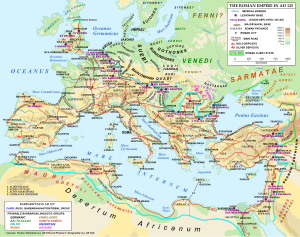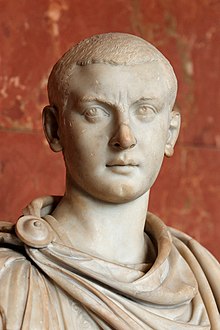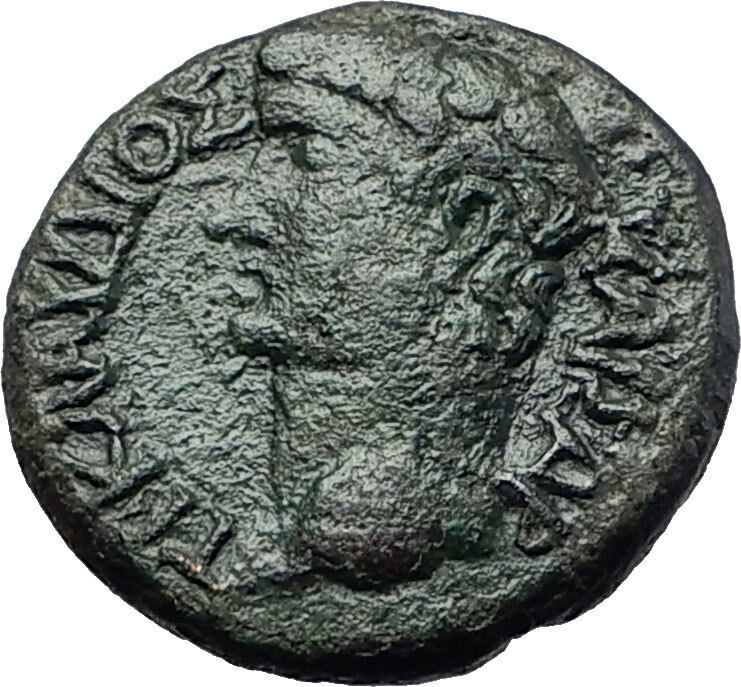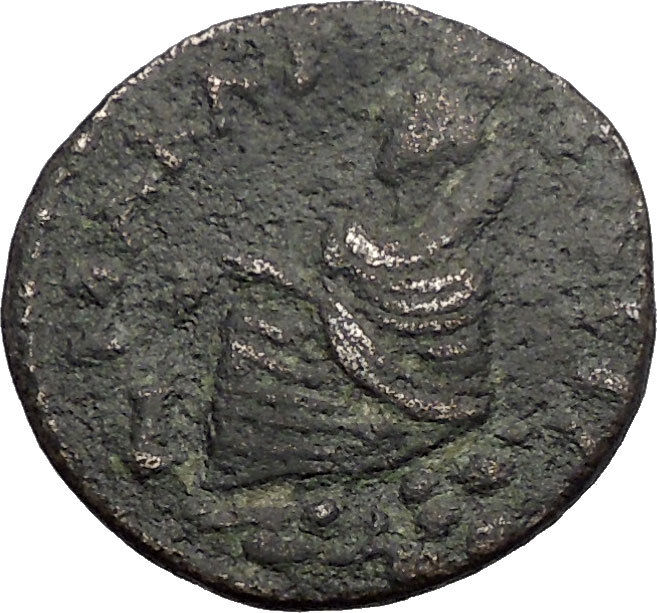|
Gordian III – Roman Emperor: 238-244 A.D.
Bronze 22mm (7.14 grams) of Viminacium in Moesia Superior
Dated CY 4, struck 242/243 A.D.
Reference: H&J, Viminacium 16; Varbanov 124
IMP GORDIANVS PIVS FEL AVG, radiate, draped and cuirassed bust right.
P M S COL VIM, Moesia standing facing, head left, holding vexilla inscribed VII and IIII; to left, bull standing right; to right, lion standing left; AN IIII (date) in exergue.
Viminacium was a major city of the Roman province of Moesia (today’s Serbia), and the capital of Moesia Superior. Viminacium was the base camp of Legio VII Claudia, and hosted for some time the Legio IIII Flavia Felix. The bull and the lion depicted on the coins from the city were the symbols of the two legions. It was destroyed in 440 by the Huns.
You are bidding on the exact item pictured, provided with a Certificate of Authenticity and Lifetime Guarantee of Authenticity.
Legio quarta Flavia Felix (“Lucky Flavian Fourth Legion”), was a legion of the Imperial Roman army founded in AD 70 by the emperor Vespasian (r. 69-79) from the ashes of the Legio IV Macedonica. The legion was active in Moesia Superior in the first half of the 5th century. The legion symbol was a lion.
During the Batavian rebellion, the IV Macedonica fought for Vespasian, but the emperor distrusted his men, probably because they had supported Vitellius two years before. Therefore IV Macedonica was disbanded, and a new Fourth legion, called Flavian Felix was levied by the emperor, who gave the legio his nomen, Flavia. Since the symbol of the legion is a lion, it was probably levied in July/August 70.
IV Flavia Felix was camped in Burnum, Dalmatia (modern Kistanje), where it replaced XI Claudia. After the Dacian invasion of 86, Domitian moved the legion to Moesia Superior, in Singidunum (modern Belgrade, Serbia), although there is some evidence of the presence of this legion, of one of its vexillationes in Viminacium (near modern-day Kostolac, Serbia), base of VII Claudia.
In 88 the Fourth participated to the retaliation invasion of Dacia (see Domitian’s Dacian War). It also participated in the Dacian Wars of Trajan, being victorious at the Second Battle of Tapae. The legion also participated at the final and decisive battle against the Dacians, conquering their capital, Sarmisegetusa.
Monuments of IV Flavia Felix have been found at Aquincum (Budapest). This suggests that a subunit replaced II Adiutrix during its absence during the wars of Lucius Verus against the Parthian empire (162-166).
In the Marcomannic Wars (166-180 AD), the fourth fought on the Danube against the Germanic tribes.
After the death of Pertinax, the IV Flavia Felix supported Septimius Severus against usurpers Pescennius Niger and Clodius Albinus.
The legion may have fought in one of the several wars against the Sassanids, but stayed in Moesia Superior until the first half of the 5th century.
This Roman Legion was featured in the beginning of the movie Gladiator where Maximus Decimus Meridius was the Legion general, leading the campaign in Germania against the Marcomanni.
Legio septima Claudia Pia Fidelis (Seventh Claudian Legion) was a Roman legion. Its emblem, as well as of all Caesar’s legions, was the bull, together with the lion.
The 7th, along with the 6th, 8th & 9th were all founded by Pompey in Spain in 65 BC. They were ordered to Cisalpine Gaul around 58 BC by Julius Caesar, and marched with him throughout the entire Gallic Wars.
Legio VII was one of the two legions used in Caesar’s invasions of Britain, and played a crucial role in The Battle of Pharsalus in 48 BC, and it existed at least until the end of the 4th century, guarding middle Danube.
Tiberius Claudius Maximus the Roman soldier who brought the head of Decebalus to emperor Trajan was serving in Legio VII Claudia.
Viminacium (VIMINACIVM) was a major city (provincial capital) and military camp of the Roman province of Moesia (today’s Serbia), and the capital of Moesia Superior. The site is located 12 km from the modern town of Kostolac in Eastern Serbia. The city dates back to the 1st century AD, and at its peak it is believed to have had 40.000 inhabitants, making it one of the biggest cities of that time. It lies on the Roman road Via Militaris. Viminacium was devastated by Huns in the 5th century, but was later rebuilt by Justinian. It was completely destroyed with the arrival of Slavs in the 6th century. Today, the archeological site occupies a total of 450 hectares, and contains remains of temples, streets, squares, amphitheatres, palaces, hippodromes and Roman baths.
 Map of the Roman empire in AD 125, under emperor Hadrian Legio VII Claudia and Legio IIII Flavia Felix stationed on the river Danube at Viminacium (Kostolac, Serbia), in Moesia Superior province, from AD 58 until the 4th century Map of the Roman empire in AD 125, under emperor Hadrian Legio VII Claudia and Legio IIII Flavia Felix stationed on the river Danube at Viminacium (Kostolac, Serbia), in Moesia Superior province, from AD 58 until the 4th century
History
The remains of Viminacium, the capital of the Roman province of Moesia Superior, are located on territories of the villages of Stari Kostolac and Drmno, about 12 km from the town of Kostolac and about 90 miles southeast of Belgrade. Viminacium was one of the most important Roman cities and military camps in the period from 1st to 4th centuries. Its exceptional strategic importance was reflected both in the defense of the northern border of the Roman empire and in turn of communications and commercial transactions. No less appealing to the Romans was the hinterland of the Mlava river valley, which is rich in ore and grains. In Roman times, the town on the northern side of relying directly on the branch of the Danube, while the western side, touching the walls Mlava rivers. Only in the later period, Viminacium spread to the left bank of Mlava. Thanks to the location, land and waterways, Viminacium represented one of those areas where the encounter of cultures between East and West was inevitable. Although these roads were the primary military and strategic function, they are taking place throughout antiquity very lively traffic and certainly contributed to the very Viminacium become prosperous and an important trading and business headquarters. In Viminacium, Roman legion VII Claudia was stationed, and a nearby civilian settlement emerged from the military camp. In 117 during the reign of Hadrian it received city status. In the camp, 6.000 soldiers were stationed, and 30-40.000 lived nearby. In the first half of the 3rd century the city was in full development, as evidenced by the fact that at that time it acquired the status of a Roman colony, and the right to coin local money. Here, in 211, Septimius Severus was proclaimed emperor by his son Caracalla. In the mausoleum and the excavated tombs, the Roman emperor Hostilian, who died in 251, was buried.
A legion may have been stationed here as early as Augustus (27 BC-14 AD). In 33/34 AD a road was built, linking Viminacium and Ratiaria. Claudius (41-54) garrisoned Viminacium, Oescus and Novae as camps for the Moesian legions.
The first legion attested at Viminacium was the VII Claudia that came from Dalmatia in 52 AD .
Emperor Trajan (98-117) was headquartered here during the Dacian Wars. It became a colonia with minting privilege in 239 AD during the rule of Gordian III (238-244) and housed the Legion VII and Legion IV.
Emperor Hostilian was the son of the emperor Decius, who was killed in the ambush near the ancient city of Abrutus located in present day Bulgaria. According to the old manuscript, emperor Hostilian and his mother came to Viminacium to supervise the organization of defense of northern borders, but both of them died of the plague. Because of the distance and the fear of spreading the plague, he was buried with all honors in Viminacium
Viminacium was the provincial capital of Moesia Superior. In the late spring of 293-294, Diocletian journeyed through his realm and he re-organized Viminacium as the capital of the new province of Moesia Superior Margensis. He registered that the people wrote in Latin, as opposed to Greek in the southern provinces. Viminacium was the base camp of Legio VII Claudia, and hosted for some time the IIII Flavia Felix. It had a Roman amphitheatre with room for 12,000 people.
In 382 the city was the meeting place between Theodosius and Gratian amidst the Gothic Wars.
Viminacium was destroyed in 441 by the Attila the Hun, but rebuilt by Justinian I. During Maurice’s Balkan campaigns, Viminacium saw destruction by the Avars in 582 and a crushing defeat of Avar forces on the northern Danube bank in 599, destroying Avar reputation for invincibility.
Location and excavation
Viminacium is located in Stari Kostolac (Old Kostolac) a Serbian town on the Danube river, east of Belgrade. Viminacium is the location of the first archaeological excavation in Serbia, which started in 1882, by Mihailo Valtrović, an architect by profession and the first professor of archeology at the college in Belgrade. The only help he received was from 12 prisoners, because the state did not have enough resources to provide him with a better work force. His research was continued by Miloje Vasić, in the 1970s. It has intensified in the last ten years in the area of the Roman city of the Roman legionary camps and cemeteries. Many studies suggest that the military camp at Viminacium had a rectangular plan, measuring 442 x 385 meters, and that is not far from its western wall of civilian settlement in an area of approximately 72 acres. Legionary camp in Viminacium is now in a layer of arable land, so that wealth Viminacium easily accessible to researchers, but, unfortunately, and the robbers.The National Museum in Belgrade and Požarevac kept some 40,000 items found in Viminacium, of which over 700 made of gold and silver. Among them are many objects that represent the European and world rarities invaluable.
It has been discovered and more than 13,500 graves. Tombstones and sarcophagi are often decorated with relief representations of scenes from mythology or daily life. We have found numerous grave masonry construction. Especially interesting are the frescoes of the 4th-century tombs. Fresco with the notion of young women in artistic value of the extreme range of late antique art. During the excavation, an amphitheater, which with its 12,000 seats was one of the largest in the Balkans.
Gordian III – Roman Emperor: 238-244 A.D.
Caesar: 238 A.D. (under Balbinus and Pupienus)
Augustus: 238-244 A.D.
| Grandson of Gordian I | Nephew of Gordian II | Adopted Successor of Balbinus and Pupienus | Husband of Tranquillina |

Gordian III (Latin: Marcus Antonius Gordianus Pius Augustus; 20 January 225 AD – 11 February 244 AD) was Roman Emperor from 238 AD to 244 AD. At the age of 13, he became the youngest sole legal Roman emperor throughout the existence of the united Roman Empire. Gordian was the son of Antonia Gordiana and an unnamed Roman Senator who died before 238. Antonia Gordiana was the daughter of Emperor Gordian I and younger sister of Emperor Gordian II. Very little is known of his early life before his acclamation. Gordian had assumed the name of his maternal grandfather in 238 AD.
In 235, following the murder of Emperor Alexander Severus in Moguntiacum (modern Mainz), the capital of the Roman province Germania Superior, Maximinus Thrax was acclaimed Emperor. In the following years, there was a growing opposition against Maximinus in the Roman senate and amongst the majority of the population of Rome. In 238 a rebellion broke out in the Africa Province, where Gordian’s grandfather and uncle, Gordian I and II, were proclaimed joint emperors. This revolt was suppressed within a month by Cappellianus, governor of Numidia and a loyal supporter of Maximinus Thrax. The elder Gordians died, but public opinion cherished their memory as peace-loving and literate men, victims of Maximinus’ oppression.
Meanwhile, Maximinus was on the verge of marching on Rome and the Senate elected Pupienus and Balbinus as joint emperors. These senators were not popular men and the population of Rome was still shocked by the elder Gordian’s fate, so the Senate decided to take the teenager Gordian, rename him Marcus Antonius Gordianus like his grandfather, and raise him to the rank of Caesar and imperial heir. Pupienus and Balbinus defeated Maximinus, mainly due to the defection of several legions, particularly the II Parthica, who assassinated Maximinus. However, their joint reign was doomed from the start with popular riots, military discontent and an enormous fire that consumed Rome in June 238. On July 29, Pupienus and Balbinus were killed by the Praetorian Guard and Gordian proclaimed sole emperor.
Rule
Due to Gordian’s age, the imperial government was surrendered to the aristocratic families, who controlled the affairs of Rome through the Senate. In 240, Sabinianus revolted in the African province, but the situation was quickly brought under control. In 241, Gordian was married to Furia Sabinia Tranquillina, daughter of the newly appointed praetorian prefect, Timesitheus. As chief of the Praetorian Guard and father in law of the Emperor, Timesitheus quickly became the de facto ruler of the Roman Empire.
In the 3rd century, the Roman frontiers weakened against the Germanic tribes across the Rhine and Danube, and the Sassanid Empire across the Euphrates increased its own attacks. When the Persians under Shapur I invaded Mesopotamia, the young emperor opened the doors of the Temple of Janus for the last time in Roman history, and sent a large army to the East. The Sassanids were driven back over the Euphrates and defeated in the Battle of Resaena (243). The campaign was a success and Gordian, who had joined the army, was planning an invasion of the enemy’s territory, when his father-in-law died in unclear circumstances. Without Timesitheus, the campaign, and the Emperor’s security, were at risk.
Gaius Julius Priscus and, later on, his own brother Marcus Julius Philippus, also known as Philip the Arab, stepped in at this moment as the new Praetorian Prefects and the campaign proceeded. Around February 244, the Persians fought back fiercely to halt the Roman advance to Ctesiphon. Persian sources claim that a battle occurred (Battle of Misiche) near modern Fallujah (Iraq) and resulted in a major Roman defeat and the death of Gordian III. Roman sources do not mention this battle and suggest that Gordian died far away from Misiche, at Zaitha (Qalat es Salihiyah) in northern Mesopotamia. Modern scholarship does not unanimously accept this course of the events. One view holds that Gordian died at Zaitha, murdered by his frustrated army, while the role of Philip is unknown. Other scholars, such as Kettenhofen, Hartman and Winter have concluded that Gordian died in battle against the Sassanids.
Philip transferred the body of the deceased emperor to Rome and arranged for his deification. Gordian’s youth and good nature, along with the deaths of his grandfather and uncle and his own tragic fate at the hands of the enemy, earned him the lasting esteem of the Romans. The soldiers held Gordian in high esteem, as he had possibly sacrificed his life to save them in 244.
|





 Map of the Roman empire in AD 125, under emperor Hadrian Legio VII Claudia and Legio IIII Flavia Felix stationed on the river Danube at Viminacium (Kostolac, Serbia), in Moesia Superior province, from AD 58 until the 4th century
Map of the Roman empire in AD 125, under emperor Hadrian Legio VII Claudia and Legio IIII Flavia Felix stationed on the river Danube at Viminacium (Kostolac, Serbia), in Moesia Superior province, from AD 58 until the 4th century





